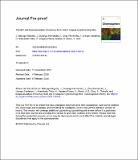Por favor, use este identificador para citar o enlazar a este item:
http://hdl.handle.net/10261/201176COMPARTIR / EXPORTAR:
 SHARE SHARE
 CORE
BASE CORE
BASE
|
|
| Visualizar otros formatos: MARC | Dublin Core | RDF | ORE | MODS | METS | DIDL | DATACITE | |

| Título: | Transfer and bioaccumulation of mercury from soil in cowpea in gold mining sites |
Autor: | Marrugo-Negrete, José Luis; Durango-Hernández, José David; Díaz-Fernández, L.; Urango-Cárdenas, Iván; Araméndiz-Tatis, H.; Vergara-Flores, V.; Bravo, Andrea G. CSIC ORCID ; Díez, Sergi CSIC ORCID | Palabras clave: | Cowpea Phytoextraction Mercury Vigna unguiculata L. Walp Health risks Healthy food |
Fecha de publicación: | 8-feb-2020 | Editor: | Elsevier | Citación: | Chemosphere 126142 (2020) | Resumen: | In this study, we evaluated the phytoremediation ability of three different genotypes of cowpea grown on mercury-contaminated soils from gold mining areas. In particular we compared a native genotype with two commercial lines L-019 and L-042. The plants were cultivated in soils amended at different concentrations of Hg (i.e. 0.2, 1, 2, 5 and 8 mg kg−1). After three months exposure, we determined plant growth, seed production, and Hg accumulation in different plant tissues (root, leaf, seed and stem). Indices of soil-plant metal transfer such as translocation, bioconcentration and bioaccumulation factors were calculated. Results showed that the native variety presented the highest seed production (3.8 g), however the highest plant biomass (7.9 g) was observed in line L-019, both on Hg-contaminated soil of 1 mg kg−1. The different plant tissues differed in terms of Hg concentration (root > leaf > stem). In the highest treated soil, the line L-042 accumulates higher Hg in both roots and leaves, while line L-019 accumulates more metal in stems. In line L-019, Hg concentrations in the fruit showed significant differences being higher in the valves than in the seeds. The transfer factors were generally lower than 1 and indicates the low accumulation of Hg by cowpeas. The estimated daily Hg intake through cowpea consumption showed values far below the threshold of 0.57 μg kg−1 dw day−1 recommended by the World Health Organization. Our results show cowpea V. unguiculata as a good protein-rich food substitute of Hg-contaminated fish for populations living near gold mining sites. | Versión del editor: | https://doi.org/10.1016/j.chemosphere.2020.126142 | URI: | http://hdl.handle.net/10261/201176 | DOI: | 10.1016/j.chemosphere.2020.126142 |
| Aparece en las colecciones: | (IDAEA) Artículos |
Ficheros en este ítem:
| Fichero | Descripción | Tamaño | Formato | |
|---|---|---|---|---|
| Transfer and bioaccumulation of mercury from 5 soil in cowpea in.pdf | Artículo principal | 2,54 MB | Adobe PDF |  Visualizar/Abrir |
| 1-s2.0-S0045653520303350-mmc1.docx | Material suplementario | 19,81 kB | Microsoft Word XML | Visualizar/Abrir |
CORE Recommender
SCOPUSTM
Citations
12
checked on 17-abr-2024
WEB OF SCIENCETM
Citations
12
checked on 28-feb-2024
Page view(s)
189
checked on 19-abr-2024
Download(s)
258
checked on 19-abr-2024
Google ScholarTM
Check
Altmetric
Altmetric
NOTA: Los ítems de Digital.CSIC están protegidos por copyright, con todos los derechos reservados, a menos que se indique lo contrario.


